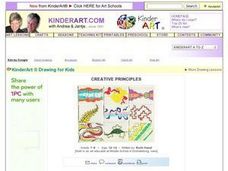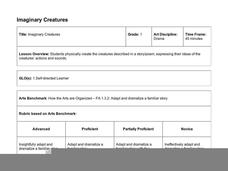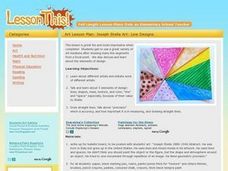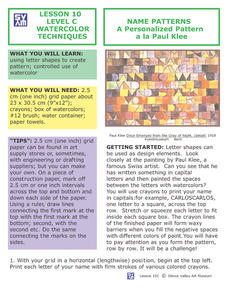National Gallery of Canada
My Upside-Down World!
M.C. Escher is famous for creating optical illusions. Examine this effect in several of his works and discuss the techniques involved. Inspired by the discussion, learners create an imaginary 3-D world inside of a box using various...
Hawaiʻi State Department of Education
Poems That Dance
Combine the elements of dance with the actions in a poem. Learners review basic grammar, write an action-packed cinquain poem, and then choreograph a dance based on their cinquains. After the dances are done, they'll discuss the elements...
Curated OER
CREATIVE PRINCIPLES
Jr. high learners review the basic principles of design (balance, unity, movement, rhythm, pattern, contrast and emphasis) by watching a video by Gerald Brommer. Then they provide "aerobic exercise" for the right side of their brains by...
Hawaiʻi State Department of Education
Imaginary Creatures
Drama and movement are wonderful ways to cover story elements such as setting, character, and descriptive writing. Little ones listen to a poem about imaginary creatures. As they listen, they shape their bodies into what they think the...
Hawaiʻi State Department of Education
What’s My Vocabulary Word?
The elements of dance can be used to communicate thoughts and, in this case, words. In small groups, the class first creates a set of movements to show a single word. Then, they extend their movements to show a three-word phrase....
Hawaiʻi State Department of Education
Puppet Scenes
Explore character, plot, and setting through dramatic puppet play. Second graders discuss basic story elements and then practice making a character with their sock puppets. After they've crafted a dynamic puppet, they pair up to create a...
Hawaiʻi State Department of Education
Comparing Themes
The tale of "Lon Po Po" is a Chinese story, very similar to the European tale of "Little Red Riding Hood." Learners make cross cultural comparisons between the two tales, focusing on themes common to both. They review story elements such...
Curated OER
Elementary My Dear Dancer-Foundation Lesson
Students participate in dance choreography. In this choreography lesson plan, students classify elements of choreography. Students collaborate in small groups and compose choreography.
Hawaiʻi State Department of Education
Story Design
Stories contain very specific elements; plot, characters, and key events. Learners use pantomime to retell a key event from the beginning, middle, and end of a story. They discuss setting and character as each group discusses and then...
Curated OER
Pen and Ink Drawing
Learners hone their drawing techniques to create a nature-inspired piece of art. They practice hatching, cross hatching, stippling, and shading. They discuss how each method is better suited for creating specific elements in nature such...
Curated OER
Pop-Up Pop Art, Tunnel book
Students study iconic symbols Keith Haring would make in his artwork. They invent a background for the images, and draw the characters. Students create a Tunnel Book and a Pop-Up Book based on their drawings.
Curated OER
Informal Group Portraits
Students explain one artist's approach to the Impressionist's use of art elements and design principles. They create an Impressionistic painting that contains two figures.
Curated OER
Joseph Stella Art: Line Designs
Students discover the focal point in pictures and create their own images using lines and space. In this art analysis lesson, students create a black dot on a white paper which becomes a focal point for the lines the student will paint...
Curated OER
Gianfranco Gorgoni
Students analyze creation of the Earth Art and examine differences between aesthetic work and work created for function. In this art analysis lesson, students analyze photographs from various projects for the art elements of line, shape,...
Curated OER
The Art of Description
Students apply descriptive language to identify the five elements of art and the basic lines, geometric shapes, and angles in Marie Hull's, Sharecropper. They explain how the elements of a piece of work contribute to the story it tells....
Curated OER
Lesson New Museum: Exploring the Building
Explore the possibilities of buildings, public spaces, and architectural design. Learners examine the work of SANAA architects Sejima & Nishizawa through background information, images, and guided class discussion. This lesson...
Japan Society
Japanese Architecture for High School Students
Japanese architecture is rich in symbolism and culture. Critical thinkers engage in three activities intended to expose them to the beauty of Japan. They read through the book, Praise of Shadows by Junichiro Tanizaki and watch the film...
Sargent Art
Picasso and Beyond!
After reviewing the life and art of Pablo Picasso, learners set out to create abstract, cubist, relief portraits. They'll draw, color, paint, and cut out portraits just like the ones Picasso created. The lesson is extremely well written...
Asian Art Museum
Japanese Architecture for Elementary School Students
Art and architecture go hand-in-hand. Kids watch clips from the Hayo Miyazaki film Spirited Away to better understand Japanese customs and architecture. The discussion questions included are very good, and will help you lead the class in...
Curated OER
Name Patterns
Here is a fun, colorful, and engaging art project that is sure to get your kids excited! They make a piece of art using watercolor paints, and by making a design out of the letters of their first name. This would be a fantasti art...
J. Paul Getty Trust
Still-Life Painting: Arranging Nature—Lesson 1
Art learners examine still-life arrangement images and respond to a series of prompts. In a whole-class discussion, pupils list elements and qualities that still-life paintings can have. After instructors create an arrangement and model...
Blake Education
Drama Warm Ups
Here's a 15-page packet packed with ideas for warm-up activities that can be used for drama classes or in content courses. Each activity is coded to indicate materials needed, space requirements and appropriate audience. A great addition...
Armory Center for the Arts
Place Value Collage
How can art represent math? Use a lesson on place value collages to illustrate the different meanings that numbers have in their designated places. Kids observe photographs and paintings that show place value, then work on their own.
Curated OER
Colored Pencil Value Practice
Budding artists discover what color value means with regard to art. They read the definition of color value at the top of the page, choose three different colored pencils, then use the provided spaces to create color values with each. By...
Other popular searches
- Elements of Art Space
- Elements of Art (Space)
- Space Art Element
- Elements of Visual Art Space
- Space Element of Art

























